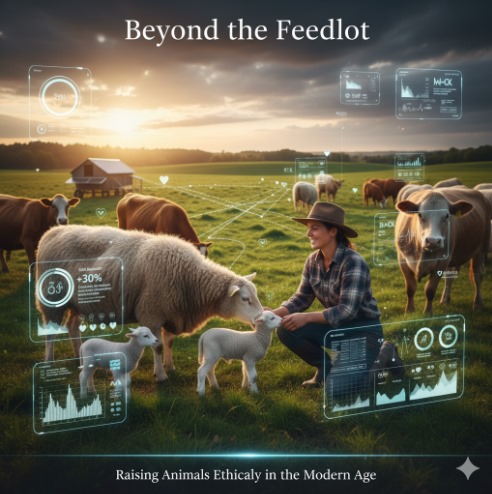Beyond the Feedlot: Raising Animals Ethically in the Modern Age
In recent years, a significant shift has occurred in how consumers view their food, particularly meat and dairy products. There's a rapidly growing demand for food produced with integrity – a desire to know that the animals were treated well, and the farming practices were kind to the planet. This has pushed the conversation beyond the feedlot, challenging conventional industrial farming methods and highlighting the importance of ethical livestock farming and sustainable animal agriculture. Farmers today face the dual challenge of meeting this rising consumer expectation while upholding their environmental responsibilities. So, what does it mean to raise animals ethically in the modern age, and how are farmers embracing these crucial principles? The Heart of the Matter: Humane Animal Treatment At its core, ethical farming prioritizes humane animal treatment. This means moving away from practices that cause stress or suffering and instead focusing on environments and care that allow animals to express natural behaviors. Space to Thrive: A fundamental aspect is providing ample space. This often translates to pasture-raised systems for ruminants like cattle and sheep, where animals have access to open fields for grazing. For poultry, free-range certification ensures birds can roam outdoors, scratch, and dust bathe. Enrichment and Comfort: Beyond just space, it's about providing an enriched environment. This can include access to shade, clean bedding, proper ventilation, and even toys or objects that stimulate natural behaviors. Stress Reduction: Ethical practices aim to minimize stress throughout an animal's life, from handling techniques to transportation and processing. This not only improves animal welfare but can also result in higher quality products. Beyond Welfare: Sustainable Animal Agriculture Ethical livestock farming isn't just about the animals; it's also deeply intertwined with the health of our planet. Sustainable animal agriculture considers the environmental impact of farming practices and strives to minimize harm while enhancing ecological balance. Regenerative Grazing: This is a revolutionary approach, especially for cattle and sheep, where animals are moved frequently between small paddocks. This mimics natural grazing patterns, allowing pastures ample time to recover, promoting deeper root growth, increasing soil organic matter, and enhancing biodiversity. Regenerative grazing turns livestock into a tool for environmental restoration, improving soil health, water retention, and carbon sequestration. Reduced Chemical Input: Sustainable farms often reduce or eliminate the use of synthetic fertilizers, pesticides, and herbicides, relying instead on natural cycles and biological controls. Resource Management: Efficient water use, responsible waste management (e.g., composting manure), and energy conservation are all hallmarks of sustainable operations. Meeting Consumer Demand: Transparency and Certification Consumers are increasingly willing to pay a premium for ethically raised products, but they also demand transparency. How can farmers communicate their commitment to animal welfare standards and sustainable practices effectively? Third-Party Certifications: A growing number of independent organizations offer certifications (e.g., Animal Welfare Approved, Certified Humane, Global Animal Partnership) that provide clear, verifiable standards for animal care and environmental stewardship. These labels help consumers make informed choices. Direct-to-Consumer Models: Many ethical farmers connect directly with their customers through farmers' markets, farm shares (CSAs), and online sales. This allows for direct communication, farm tours, and building trust through personal relationships. Storytelling and Education: Sharing the farm's story, explaining practices through social media, blogs, and on-farm events, educates consumers and builds a loyal customer base who appreciate the extra effort. The Farmer's Role: Guardians of Land and Livestock Embracing ethical and sustainable practices often requires significant investment, hard work, and a deep commitment to animal welfare and environmental stewardship. It's a testament to the dedication of farmers who choose this path, becoming not just food producers, but guardians of their land and their livestock. The journey beyond the feedlot is a collective one, involving informed consumers, innovative farmers, and supportive policies. It's about recognizing that the choices we make, both as producers and consumers, have a profound impact on animal lives and the health of our planet. By supporting ethical livestock farming and prioritizing humane animal treatment, we can cultivate a food system that aligns with our values and ensures a healthier future for all.
Mr. Diyan Ahmed


Connect
Partnering for innovation across industries.
Explore
Discover
+923001534092
© 2025. All rights reserved.
